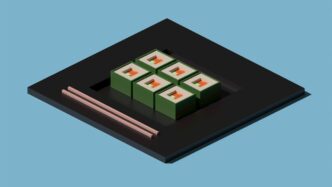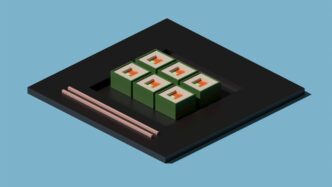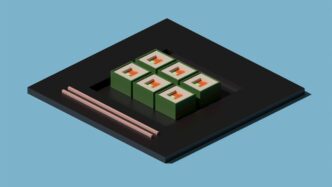China is really pushing ahead with quantum computers, and it feels like we’re on the edge of something big. They’ve got this whole national strategy going, pouring money into labs and trying to get the best minds working on it. It’s not just talk, either. They’ve been making some serious progress with their actual machines, like the Zuchongzhi-3, which is apparently super fast. Plus, companies are starting to figure out how to actually make and sell this stuff, and people are already looking at how it could change fields like medicine and finance. Of course, it’s not all smooth sailing; there are still big hurdles to jump, like making these computers bigger and more reliable. But overall, the focus on quantum computer china is clear: they want to be a major player.
Key Takeaways
- China has a clear national strategy for quantum computing, backed by significant policy and funding, aimed at developing a robust quantum ecosystem.
- Breakthroughs in measurement and control systems allow for precise handling of many qubits, speeding up computations and improving stability.
- Superconducting quantum computers like Zuchongzhi-3 are showing impressive performance, challenging global benchmarks and sparking discussions about quantum supremacy.
- Efforts are underway to industrialize quantum technology, with companies like Origin Quantum working on iterative production and commercial applications.
- The development of quantum computer china is driven by potential applications in secure communications, financial modeling, and biomedical research, though scaling and error reduction remain significant challenges.
China’s Quantum Computing Ambitions and National Strategy
China is really going all-in on quantum computing. It’s not just a research project; it’s a big part of their national plan. They see this as a way to lead in future technology, kind of like how countries compete in other big tech areas. This push started gaining serious steam around 2020, moving from just thinking about it to actually trying to build things and make them work.
Policy Milestones and Funding Initiatives
So, the government has been putting serious money and effort into this. Think major plans like the 14th Five-Year Plan, which specifically called out quantum information as a priority. They’ve also had big meetings, like the Central Economic Work Conference, where they decided to put billions of yuan into quantum projects. It’s a pretty clear signal that this is important. They’ve set up special national labs, like the one in Hefei for Quantum Information Sciences and another in the Guangdong-Hong Kong-Macao Greater Bay Area. These places are meant to be hubs, bringing people together to coordinate research and get the industry moving. It’s a top-down approach, for sure.
Establishing National Quantum Laboratories
These national labs are a pretty big deal. They’re not just buildings; they’re meant to be centers of excellence. The idea is to concentrate resources and talent in specific locations to really push the boundaries. We’re talking about facilities that have received over 20 billion CNY in investment. That’s a huge amount of money, showing how serious they are about creating a strong foundation for quantum research and development. These labs are supposed to coordinate efforts across the country, making sure everyone is working towards the same big goals.
Prioritizing Talent Development in Quantum Science
Of course, none of this works without people. China knows that. The Ministry of Education put out a notice in 2024 encouraging universities to start offering programs in quantum information science. It’s a direct response to what the industry needs. As of now, in 2025, at least 13 universities have these specialized courses. This is all about building a pipeline of skilled researchers and engineers. They need people who understand the complex physics and can also build and operate these advanced machines. It’s a long-term play to make sure they have the brainpower to keep leading in this field.
Breakthroughs in Quantum Measurement and Control Systems
So, controlling quantum computers has always been a bit of a headache, right? You’ve got these super delicate qubits, and trying to get them to do exactly what you want without messing them up is tough. For ages, scientists have been wrestling with how to manage a bunch of qubits at once without them interfering with each other, and how to make sure the information from each one is spot on. China’s recent advancements in quantum measurement and control systems are really changing the game here.
Overcoming Bottlenecks in Qubit Control
It used to be that controlling more than a handful of qubits precisely was a major hurdle. Imagine trying to conduct a symphony where each musician is incredibly sensitive to the slightest sound from their neighbor – it’s that kind of challenge. China has managed to get past this. They’ve developed systems that can precisely manipulate and monitor many qubits in real-time. This is a big deal because it means we can start thinking about quantum computers that are much more capable than what we had before. It’s like finally figuring out how to get all those sensitive musicians to play in harmony.
Achieving Unprecedented Scale and Accuracy
What’s really impressive is the jump in scale. We’re talking about moving from controlling dozens of qubits to managing over 5,000. That’s a massive leap, both in terms of quantity and the precision involved. This kind of large-scale, accurate control is what takes quantum computing from a cool lab experiment to something that might actually be useful in the real world. It makes the technology much more practical and opens doors for commercial uses. Precision control electronics and cryogenic infrastructure are key to these superconducting and NMR platforms, with systems like SpinQ’s Quantum Control Measurement (QCM) playing a role in scalable qubit control [c763].
Enabling Faster Computational Speeds and Stability
With these new measurement and control systems, we’re seeing some pretty significant improvements. For starters, computational speeds are getting faster. That’s always a good thing when you’re talking about computers. But it’s not just about speed; stability is also getting better. Delicate quantum states are less likely to get messed up, which means the computations are more reliable. This improved stability and speed are paving the way for broader practical applications, moving quantum computing beyond theoretical discussions into tangible problem-solving.
Superconducting Quantum Computer Advancements
China’s progress in superconducting quantum computing is really something to watch. These systems, which use things like Josephson junctions and need to be kept super cold (around 20 millikelvin), are currently the most developed platform for quantum computers in the country. They’ve managed to get qubits to stay in their quantum state for decent lengths of time, between 20 and 100 microseconds, and can perform single-qubit operations with over 99.9 percent accuracy. That’s pretty impressive.
The Zuchongzhi-3 Processor’s Performance
The Zuchongzhi-3 processor is a big deal. It’s built with 105 transmon qubits, which are designed to be less sensitive to noise. This is a step up from earlier versions. The real headline here is its performance on a task called random circuit sampling. This is a standard test to see how well a quantum computer can do something that’s really hard for regular computers. Zuchongzhi-3 reportedly completed this task much, much faster than even Google’s latest experiments, and quadrillions of times faster than the best supercomputers we have today. It’s a significant leap.
Rivaling and Surpassing Global Benchmarks
When you look at the numbers, Zuchongzhi-3 is definitely in the top tier, going head-to-head with global leaders. While some specific metrics, like two-qubit gate fidelity, might be slightly edged out by competitors like Google’s latest chips (99.62% for Zuchongzhi-3 versus 99.86% for Google’s), the overall performance, especially on complex sampling tasks, is remarkable. It’s not just keeping pace; in some areas, it’s setting new standards.
Here’s a quick look at some reported figures:
| Metric | Zuchongzhi-3 (approx.) | Google’s Willow QPU (approx.) |
|---|---|---|
| Single-Qubit Fidelity | 99.90% | 99.97% |
| Two-Qubit Fidelity | 99.62% | 99.86% |
| Qubit Count | 105 | Not specified |
Implications for Quantum Supremacy Claims
These advancements, particularly Zuchongzhi-3’s performance, really fuel the ongoing discussion about quantum supremacy. When a quantum computer can solve a problem that’s practically impossible for even the most powerful classical supercomputers, that’s a big moment. China’s work here, especially on these complex sampling problems, provides strong evidence that they are pushing the boundaries of what’s computationally possible. It suggests we’re moving closer to a point where quantum computers can tackle real-world problems that are currently out of reach for classical machines, potentially changing the landscape of scientific research and technology.
Industrialization and Commercialization of Quantum Technology
It’s not just about building the machines anymore; China is really pushing to make quantum tech a real-world product. Companies are working hard to move these complex systems from labs into practical use. This means figuring out how to build them reliably and, importantly, how to sell them.
Origin Quantum’s Iterative Engineering Production
Origin Quantum, for instance, has been busy refining its engineering. They’ve taken their previous models, like the 3.0 version that powered the Origin Wukong superconducting quantum computer, and built upon them. The Wukong system itself has been quite busy since early 2024, serving users globally and completing a huge number of quantum computing tasks across different fields. This kind of iterative process, where you build, test, and improve, is key to making quantum computers more robust and accessible. It shows a commitment to not just theoretical progress but also to creating usable hardware.
The Role of Measurement and Control Systems
Getting these quantum computers to work right relies heavily on their measurement and control systems. Think of it like the brain and nervous system of the computer. China has made some big strides here, with the ability to precisely control over 5,000 qubits. This level of control is a huge step forward, moving quantum technology from just an idea to something that can actually be applied. It’s this kind of advancement that really fuels the push towards practical applications and helps build confidence in the technology’s potential. This progress is a significant part of China’s industrial intelligence.
Applications Across Diverse Industries
So, where is this all heading? Well, the applications are starting to pop up everywhere. We’re seeing quantum computing being explored in:
- Finance: Banks are looking at how quantum can help with things like managing investment portfolios and assessing risk more quickly.
- Biomedicine: Researchers are using quantum approaches to tackle complex problems like assembling genomes, which could speed up drug discovery.
- Materials Science: Simulating molecules to find new materials or better catalysts is another big area.
- Secure Communications: While not strictly computing, the underlying quantum principles are vital for developing unbreakable encryption methods.
It’s a broad spectrum, and as the technology matures and becomes more available, we’ll likely see even more unexpected uses emerge. The goal is to move beyond just academic curiosity and into solving real-world problems that are currently out of reach for even the most powerful classical computers.
Applications Driving the Quantum Era
So, what’s all this quantum computing power actually good for? It’s not just about faster calculations for the sake of it. We’re talking about tackling problems that were basically impossible before. Think about secure communications – quantum key distribution is already showing promise for unbreakable encryption. Imagine a world where your sensitive data is truly safe from prying eyes. That’s a big deal.
Then there’s the financial world. Banks are looking at quantum computers to do some serious number crunching. They’re testing out ways to manage investment portfolios and figure out risks way faster than current systems allow. It could change how markets operate.
And in medicine? This is where it gets really interesting. Quantum computers could help us piece together complex genetic information, like assembling a giant puzzle. This could speed up the discovery of new drugs and lead to more personalized treatments. It’s like giving doctors and researchers a super-powered microscope for biology.
Here’s a quick look at some key areas:
- Secure Communications: Developing encryption methods that are theoretically impossible to break.
- Financial Modeling: Optimizing investment strategies and managing financial risks with greater speed and accuracy.
- Biomedical Research: Accelerating drug discovery and improving genome sequencing and analysis.
- Materials Science: Simulating molecular interactions to design new materials with specific properties.
- Artificial Intelligence: Boosting AI’s data processing capabilities for more advanced learning and decision-making.
Challenges and Future Directions for China’s Quantum Computing
Scaling Qubits and Reducing Error Rates
So, even with all the amazing progress, there are still some big hurdles to jump. The main one? Making quantum computers bigger and better. We’re talking about adding more qubits, which are like the basic building blocks of these machines. But it’s not just about cramming more in; they also need to stay stable and not mess up too often. Think of it like trying to build a really tall tower out of wobbly Jenga blocks – tricky business.
Infrastructure Requirements for Superconducting Systems
These fancy superconducting quantum computers need some serious real estate and special conditions. They require super cold temperatures, like, colder than outer space, and they can’t have any vibrations messing things up. This means building and maintaining these specialized facilities is a huge undertaking, and it costs a pretty penny. It’s not something you can just set up in your garage.
Expanding Talent Pipelines and Interdisciplinary Training
To keep this quantum revolution going, China needs more smart people who know their stuff. This means not just training more physicists, but also people who can bridge the gap between quantum tech and other fields like computer science, engineering, and even biology. We need folks who can actually figure out how to use these powerful machines to solve real-world problems. It’s about getting more people involved and making sure they have the right skills for the job.
A New Chapter in Computing
So, what does all this mean? China’s work on quantum computers isn’t just about building faster machines. It’s about opening doors to solving problems we can’t even touch right now, like creating new medicines or materials. Companies and researchers are pushing ahead, making these complex systems more accessible. While there are still hurdles to clear, like making these machines more stable and easier to build, it feels like we’re really at the start of something big. This progress puts China in a strong position for what’s next in technology, and it’s going to be interesting to see how it all plays out.
Frequently Asked Questions
What is a quantum computer and why is it important?
A quantum computer is a super-powerful type of computer that uses the weird rules of tiny particles (like atoms) to do calculations. It’s important because it can solve certain problems that regular computers can’t, like discovering new medicines or creating super-secure codes.
What does ‘quantum supremacy’ mean?
Quantum supremacy is like a race where a quantum computer proves it can do a specific task much, much faster than even the best regular supercomputer. It shows that quantum computers are becoming truly powerful.
What is the Zuchongzhi-3 processor?
The Zuchongzhi-3 is a special quantum computer chip made in China. It’s really good at doing certain calculations, so fast that it’s much quicker than the world’s fastest regular supercomputers for those tasks.
How is China working on quantum computers?
China has a big plan to be a leader in quantum technology. They are building special labs, putting lots of money into research, and training smart people. They also have companies making and selling quantum computers and related parts.
What are some real-world uses for quantum computers?
Quantum computers could help us create new materials, make super-secure communication systems that can’t be hacked, speed up financial planning, and help scientists understand diseases better by studying our genes.
What are the biggest challenges in building quantum computers?
It’s tricky to build quantum computers. Scientists need to make more ‘qubits’ (the basic parts of a quantum computer) and make sure they don’t make mistakes. Also, these computers need very special, cold environments to work, which is hard to set up.














